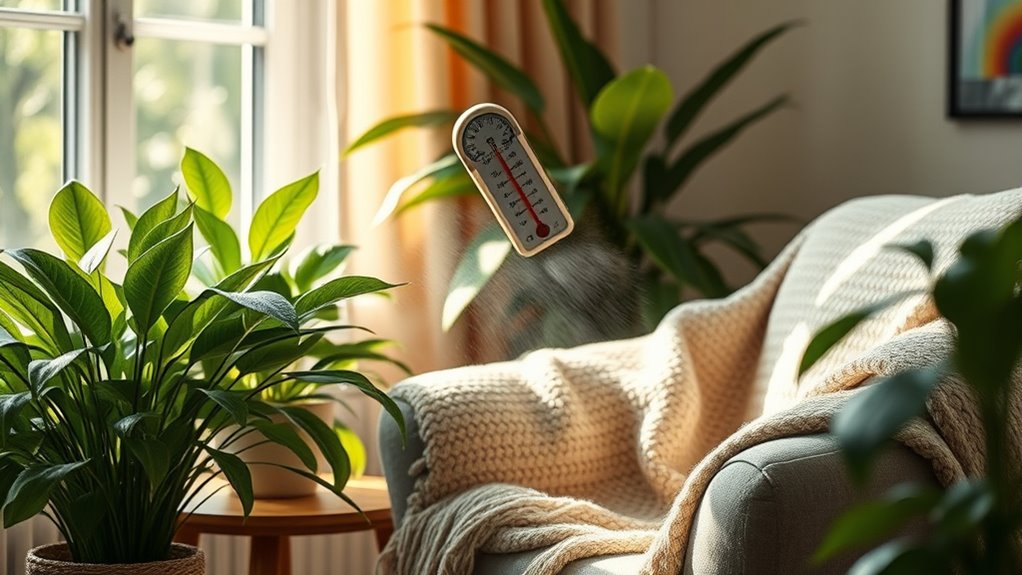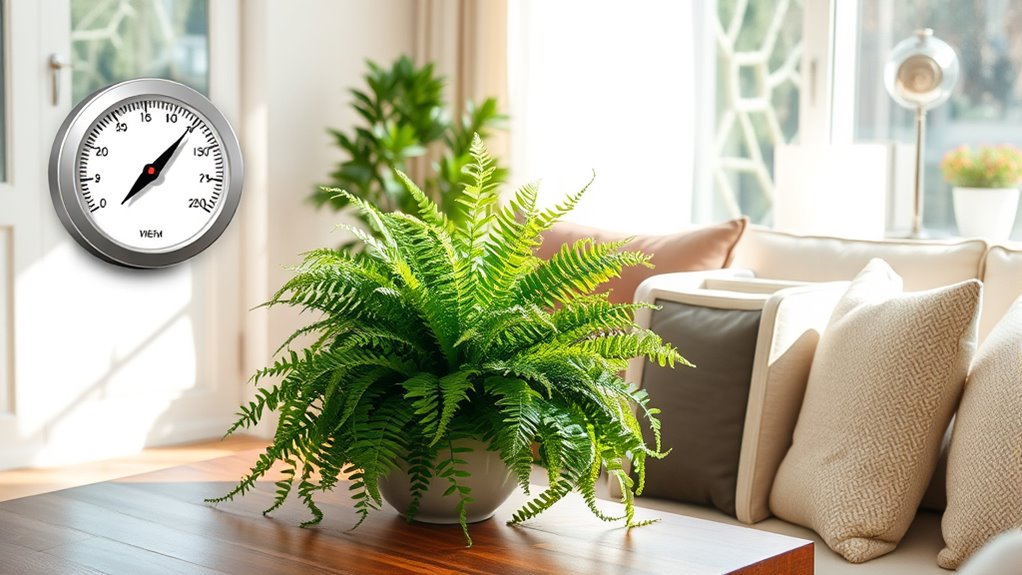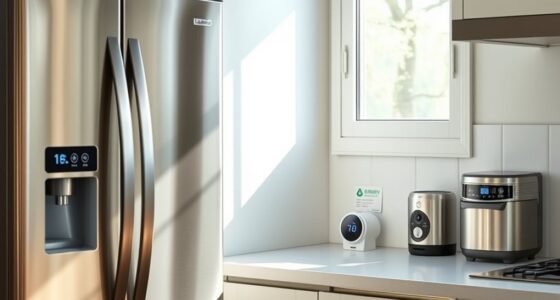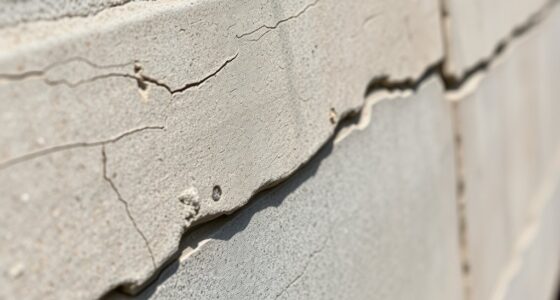Maintaining the ideal indoor humidity of 30% to 50% is key to protecting your home and health. When humidity levels stay within this range, you reduce risks like mold, dust mites, and structural damage, while also avoiding dry skin and respiratory issues. Use devices like hygrometers, humidifiers, or dehumidifiers to stay in control. Keep an eye on seasonal changes, and you’ll create a healthier, more comfortable space—plus, there’s more to discover if you continue.
Key Takeaways
- Maintain indoor humidity between 30% and 50% to promote health and prevent mold or dryness-related issues.
- Use hygrometers to accurately monitor humidity levels and adjust with humidifiers or dehumidifiers as needed.
- Reduce moisture sources like leaks, over-watering plants, and drying clothes indoors to control excess humidity.
- Ensure proper ventilation and seasonal adjustments to sustain optimal humidity throughout the year.
- Proper humidity balance protects your home’s structure, preserves furniture, and enhances overall health and comfort.

Maintaining the right humidity level in your home is essential for comfort and health, but finding that perfect balance—often called the “humidity sweet spot”—can be tricky. Too much moisture and you risk mold, dust mites, and a damp, stuffy environment. Too little, and you’ll experience dry skin, irritated sinuses, and even increased static electricity. The key is to keep your indoor humidity between 30% and 50%. This range supports your respiratory health, preserves your home’s structure, and keeps allergens at bay.
If your home’s humidity dips below this range, you’ll notice your skin feels dry and itchy, your throat becomes scratchy, and your nasal passages dry out, making you more vulnerable to colds and respiratory infections. Static shocks become more frequent, and wooden furniture or musical instruments might crack or warp. On the other hand, excessive humidity fosters mold growth, which can trigger allergies or asthma attacks. It also creates a perfect environment for dust mites and bacteria, which thrive in damp conditions. You might notice a musty smell, visible mold spots, or increased condensation on windows and walls. Over time, high humidity can even damage your home’s foundation and paint.
To maintain that ideal level, start by monitoring your indoor air with a hygrometer—an inexpensive device that measures humidity accurately. Once you know your baseline, you can take targeted steps to adjust it. If your home is too dry, using a humidifier can add moisture to the air. Be sure to clean the device regularly to prevent bacteria buildup. Conversely, if your home is too humid, a dehumidifier can help remove excess moisture. Ventilation also plays a critical role; opening windows periodically, especially after cooking or showering, helps exchange moist indoor air with drier outdoor air. Using exhaust fans in bathrooms and kitchens reduces humidity from everyday activities.
Planting houseplants can slightly increase humidity, so be mindful if you’re already near the upper limit. Conversely, reducing sources of moisture—like fixing leaks, drying clothes outside, or avoiding over-watering plants—helps keep humidity in check. Seasonal changes will influence your home’s humidity levels, so adjust your strategies accordingly. During winter, heating tends to dry out air, so a humidifier can be particularly beneficial. In summer, air conditioning and ventilation often reduce humidity, but if your home feels damp, a dehumidifier is worth considering. Additionally, understanding pinball machine weights can be helpful if you plan to move or install heavy equipment, ensuring proper handling and safety.
Achieving and maintaining that humidity sweet spot is a balancing act, but it’s worth the effort. It creates a healthier, more comfortable living environment and protects your home from moisture-related damage. With a little monitoring and adjustment, you can enjoy the benefits of optimal indoor humidity all year round.
Frequently Asked Questions
How Does Humidity Affect Indoor Allergy Symptoms?
High humidity levels can worsen indoor allergy symptoms by promoting mold growth and dust mites, which thrive in damp environments. Low humidity causes dry air, irritating your nasal passages and making allergies worse. Maintaining a balanced humidity level, ideally between 30-50%, helps reduce allergens and keeps your air comfortable. Use a dehumidifier or humidifier as needed to create an environment that minimizes allergy triggers and supports your health.
Can Adjusting Humidity Levels Improve Sleep Quality?
Adjusting humidity levels can markedly improve your sleep quality. Studies show that maintaining indoor humidity between 40-60% reduces respiratory issues and keeps allergies at bay, helping you breathe easier. When your environment hits this sweet spot, you’ll fall asleep faster and enjoy deeper, more restful sleep. Keep your home comfortable by using a humidifier or dehumidifier, and you’ll wake up feeling refreshed and energized.
What Are the Signs of Too High or Too Low Humidity?
If your home has too high humidity, you’ll notice mold, musty odors, condensation on windows, and increased dust mites. Too low, and you might experience dry skin, irritated sinuses, static shocks, and cracked wood. You can also see peeling paint or wallpaper if humidity swings are extreme. Keeping humidity between 40-60% helps prevent these issues, so monitor levels with a hygrometer and adjust your environment accordingly.
How Often Should I Check My Home’s Humidity Levels?
You should check your home’s humidity levels at least once a month to guarantee they stay within the ideal range of 30-50%. During seasonal changes or if you notice signs of excess moisture or dryness, check more frequently, perhaps every couple of weeks. Use a reliable hygrometer, and adjust your humidifier or dehumidifier as needed to maintain a healthy, comfortable environment.
Are There Specific Humidity Recommendations for Different Rooms?
Yes, different rooms need specific humidity levels. For bedrooms and living rooms, aim for 30-50% to promote comfort and prevent mold. Kitchens and bathrooms should stay around 40-60% due to moisture from cooking and showering. Children’s rooms also benefit from maintaining this range for health. Use a hygrometer to monitor each space, adjusting humidifiers or dehumidifiers as needed to keep levels within these recommended ranges.
Conclusion
Maintaining the right humidity levels isn’t just about comfort — it can substantially impact your health. Did you know that indoor humidity levels above 60% can promote mold growth, increasing allergy risks? By keeping your home’s humidity between 40-50%, you create a healthier environment for yourself and your loved ones. Don’t wait until discomfort or illness strikes; take control now and protect your home’s air quality for a safer, more comfortable life.









